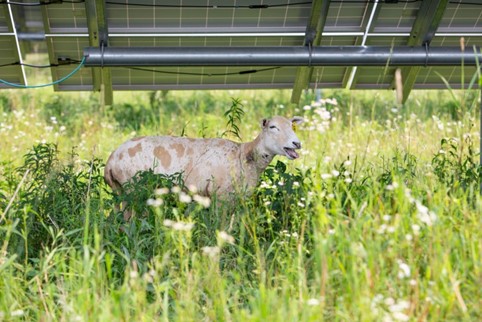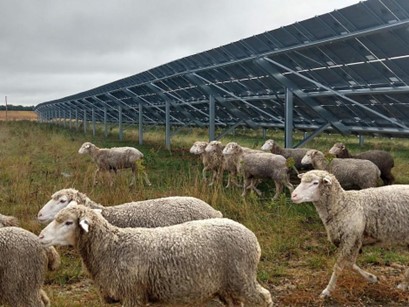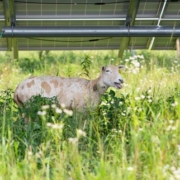Case Study: Julie Bishop, Solar Sheep LLC
American Solar Grazing Association
Julie Bishop’s involvement in the solar grazing industry began with a snowball effect after receiving a herding dog. Once she acquired a herding dog for her grazing operation, she trained it in herding at her home, which progressed to owning ewes and lambs and operating a hobby sheep farm. Then, in 2013, Bishop discovered that there was a solar field just five miles from her New Jersey home. She soon realized that sheep could manage the vegetation just as well as the traditional gas-powered mowers that were used on the site. She then got to work to make her idea a reality.
Bishop began the lengthy process of getting her sheep on that solar site. The land had originally been used as agricultural land but had been forfeited for the sole use of solar. Bishop and the solar company had to go to the municipality to ask for agriculture to be reinstated at that site. Additionally, they had to appear in front of the zoning and planning departments, send a letter to the community, and hold an open comment period in order to receive a variance. Finally, after nearly a year, Bishop was approved to move forward and was able to bring her sheep on-site for grazing.

A sheep under solar panels. Photo: American Solar Grazing Association
Despite being one of the first solar graziers and not having connections to consult, Bishop was able to successfully manage her first site. News of this success spread, and additional companies reached out to Bishop to form new contracts. Since then, she has grazed in three states.
Bishop says that solar grazing changed her life. Once a teacher, she is now a successful farmer who is only able to have her sheep operating at a larger capacity than she initially anticipated because of solar grazing. Her home farm is six acres, but the solar sites she grazes provide her the space she needs to expand her operation. She is now at the point of maximum capacity unless she changes her management style.
Currently, Bishop puts dry ewes on the solar site in the spring, then adds and removes rams, and brings the ewes home at the end of the grazing season to lamb around November and December. The lambs are then weaned, and the dry ewes return to the solar site. To expand her operation, Bishop would instead start lambing on the solar site around April and May. While the lambing process requires a lot of initial work, it would lead to a less labor-intensive and lower input management for Bishop. Along with changing the way she grazes, Bishop is waiting for more solar sites that are in close proximity to her home farm.
In addition to the challenges with expanding, Bishop identified some aspects of solar sites that can prove difficult when compared to traditional sheep management, such as site layout, trucking in water, and exterior perimeter fences that lack proper predator-proofing. After years of experience, Bishop has the knowledge and practice to overcome these challenges. For example, she worked with the solar developer at a site to build a bracket to prevent sheep from rubbing up against an emergency switch. The bracket keeps the equipment safe from the sheep but still provides easy access for a person as needed.

Sheep moving through a solar site. Photo: AgriSolar Clearinghouse
The sites that Bishop grazes were not created with the intention of solar grazing, and this can lead to difficulties such as a poor line of sight when moving sheep. Bishop has been able to overcome this issue with the assistance of a well-trained herding dog. It is only fitting that the reason she became involved in the solar grazing industry is now one of her greatest assets.
In her solar grazing work, Bishop has seen a shift in community perception. During the initial stages of solar development, there was pushback from communities that did not want agricultural land being used for solar development. Once Bishop brought the idea of solar grazing to the community, there was still some hesitation toward the new concept, and no one knew what to expect. Her success has allowed the community to view dual-use solar in a different way, and there is now a positive perception of solar grazing in her area.
As one of the first solar graziers, Bishop is well equipped to provide advice to those looking to join the industry. She suggests teaming up with someone who has experience in solar grazing to learn the ins and outs of the practice. Additionally, patience is necessary. It is difficult to plan, and there are often periods of waiting for approvals and construction. Finally, she recommends carefully selecting sheep that will be a good fit for the management system.
Bishop is a true example of the beneficial opportunities that solar grazing can provide. The additional land access granted to her through her contracts allowed her to not only expand her operation, but also to become an innovator in the expanding industry.



